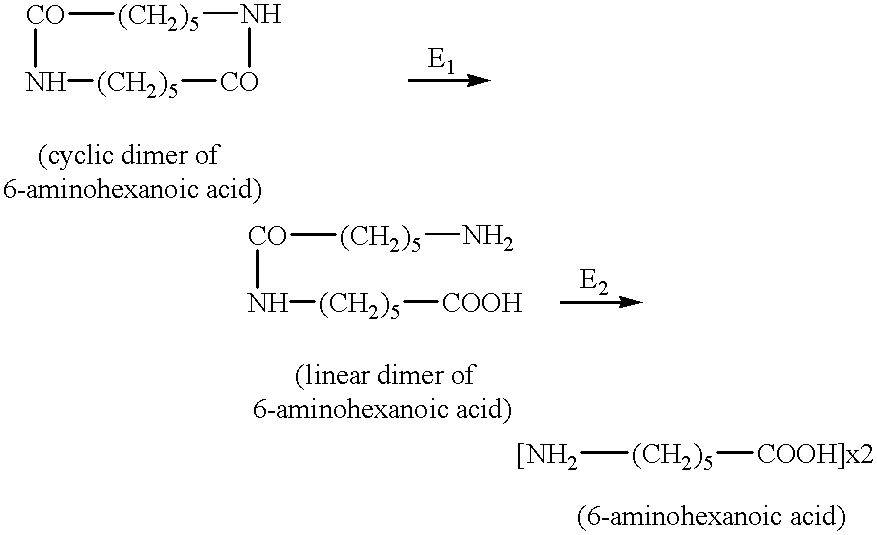Enzymes and microorganisms having amidase activity for hydrolysing polyamides
a technology of hydrolysing polyamide and enzymes, which is applied in the field of enzymes and microorganisms having amidase activity for hydrolyzing polyamide, can solve the problems of insufficient hydrolysis to be exploited on the industrial scale, low specific activity of oligomers, and poor activity of co-oligomers
- Summary
- Abstract
- Description
- Claims
- Application Information
AI Technical Summary
Problems solved by technology
Method used
Image
Examples
example i
Recombination: Expression of PAM I in E. Coli
A construction was produced in which the pam I gene (coding for the enzyme PAM I), preceded by the ribosome binding site of the phage .lambda. Cll gene, is expressed from the E. coli tryptophan operon promoter. To do this, an Ndel restriction site was created at the pam I initiation codon by the PCR technique using, as template, plasmid pXL2297 (FIG. 1) accommodated by the strain I 1495 deposited in the CNCM on Nov. 29, 1994. The 208 bp Ndel-Apal fragment containing the 5' end of the pam I gene was amplified by PCR, care being taken to introduce a Hindlll site upstream of the Ndel site by means of the pair of nucleotide primers (5'-AGCAAGCTTGGAGGCCATATGAATACGAC-3') and (5'-CACCGGTGGGCCCCTC-3'). The amplified Hindlll-Apal fragment was cloned into pUC29 (Benes et al. (1993), Gene 130: 151-152) digested by Hindlll and Apal, and the pam I gene was reconstituted by introducing the 867 bp Apal fragment of pXL2297 at the Apal site. An Ncol site ...
example ii
Comparison of the Amidase Activities of the Recombinant Strain Expressing E.sub.3 and the Recombinant Strain Expressing PAM I, as Obtained in Example I
II.1 Culture of the Strains:
The strain expressing PAM I was cultivated as indicated in Example I.
The strain expressing E.sub.3 is obtained by introducing plasmid pUCL3 into the E. coli strain TGI described in the reference "NEGORO et al. (1992)--Journal of Bacteriology, vol. 174, p. 7948-7953". This strain was cultured at 37.degree. C. in M9 medium supplemented with 100 mg / l of ampicillin and inoculated at 1% (v / v) with a preculture. An inducer (IPTG 1 mM) was added after 4 hours 30 minutes of incubation. The preculture is composed of 10 ml of the same M9 medium supplemented with 100 mg / l of ampicillin and inoculated with colonies originating from an agar dish. When culture is complete, the cell production is determined via a dry extract obtained by the drying, overnight at 105.degree. C., of a cell residue obtained after centrifugati...
example iii
Enzymatic Hydrolysis of PA 66 Oligomers with the Aid of a Mixture of PAM I Enzymes According to the Invention and Amidases E.sub.2 Expressed by the nyl-B Gene
Instead of the enzymes, the present Example utilizes their biological precursors, namely:
the recombinant strain of Example I expressing PAM I
and the recombinant strain containing the nyl-B gene of Flavobacterium sp KI 72 and expressing E.sub.2.
III.1 Culture of the Strains:
The strain expressing PAM I was cultivated as indicated in Example I.
The strain expressing E.sub.2 is obtained by the procedure described for obtaining the strain expressing E.sub.3, but by introducing plasmid pHK4 described in the reference "NEGORO et al.--Journal of Biol. Chem. (1984) 259: 13648-13651". This strain was cultured at 37.degree. C. in M9 medium supplemented with 100 mg / l of ampicillin and inoculated at 1% (v / v) with a preculture. The preculture is composed of 10 ml of the same M9 medium supplemented with 100 mg / l of ampicillin and inoculated wit...
PUM
| Property | Measurement | Unit |
|---|---|---|
| concentration | aaaaa | aaaaa |
| volume | aaaaa | aaaaa |
| pH | aaaaa | aaaaa |
Abstract
Description
Claims
Application Information
 Login to View More
Login to View More - R&D
- Intellectual Property
- Life Sciences
- Materials
- Tech Scout
- Unparalleled Data Quality
- Higher Quality Content
- 60% Fewer Hallucinations
Browse by: Latest US Patents, China's latest patents, Technical Efficacy Thesaurus, Application Domain, Technology Topic, Popular Technical Reports.
© 2025 PatSnap. All rights reserved.Legal|Privacy policy|Modern Slavery Act Transparency Statement|Sitemap|About US| Contact US: help@patsnap.com



